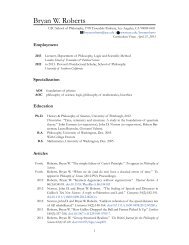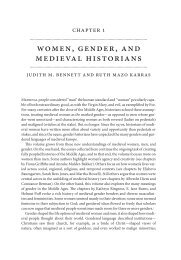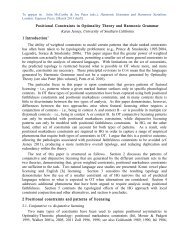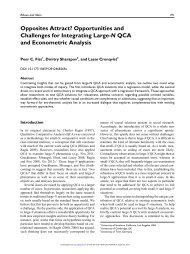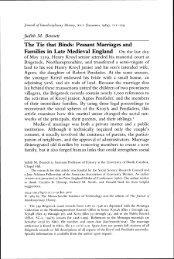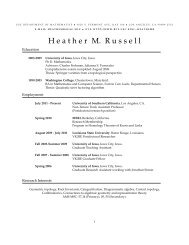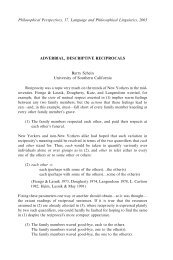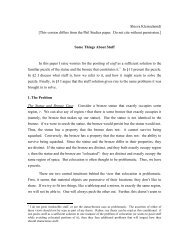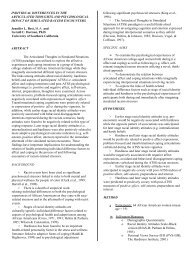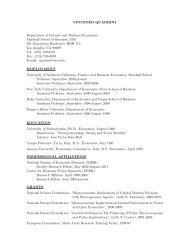The Diffusion of Ideas over Contested Terrain - Personal World Wide ...
The Diffusion of Ideas over Contested Terrain - Personal World Wide ...
The Diffusion of Ideas over Contested Terrain - Personal World Wide ...
Create successful ePaper yourself
Turn your PDF publications into a flip-book with our unique Google optimized e-Paper software.
1<br />
This internationalization <strong>of</strong> capital markets<br />
went along with the emergence <strong>of</strong> institutional<br />
investors in Germany. <strong>The</strong> shareholdings<br />
<strong>of</strong> institutional investors more<br />
than quadrupled between 1992 and 1997,<br />
from 66.5 to about 285 billion dollars. This<br />
development is driven by the increasing<br />
activity <strong>of</strong> U.S. investment funds and the<br />
emergence <strong>of</strong> domestic institutional<br />
investors; by 1999, there were 25 such<br />
domestic financial institutions that concentrated<br />
their activity mostly on those<br />
firms included in the DAX-30 index (Jürgens,<br />
Naumann, and Rupp, 2000: 71).<br />
70<br />
60<br />
50<br />
40<br />
30<br />
20<br />
10<br />
0<br />
#2144-ASQ V49 N4-December 2005—file: 49401-fiss<br />
This German view <strong>of</strong> shareholders is noteworthy both<br />
because <strong>of</strong> its longstanding tradition and its striking departure<br />
from the Anglo-American shareholder value orientation, but<br />
the German situation began to change with the increasing<br />
internationalization <strong>of</strong> capital markets that emerged in the<br />
mid-1980s. Some <strong>of</strong> the largest German corporations began<br />
to rely more on foreign investors. For example, in 1986, only<br />
23 percent <strong>of</strong> the shares <strong>of</strong> VEBA, a sizable and high-pr<strong>of</strong>ile<br />
corporation, were held by foreign investors. In 1991, this<br />
number had risen to 43 percent (Manager Magazin, 1991). 1<br />
A number <strong>of</strong> g<strong>over</strong>nment measures were also aimed at liberalizing<br />
financial regulation and promoting the growth <strong>of</strong> the<br />
German stock market. Between 1990 and 1998, the German<br />
g<strong>over</strong>nment enacted a series <strong>of</strong> three Financial Market Promotion<br />
Laws that created new markets in options and<br />
futures, set up a new regulatory body (the Federal Supervisory<br />
Office for Securities Trading), and made it easier for German<br />
companies to implement stock options and internationally<br />
accepted accounting standards.<br />
With this changing financial landscape, a growing number <strong>of</strong><br />
German firms during the 1990s also publicly proclaimed their<br />
adoption <strong>of</strong> a shareholder value orientation. Figure 1 shows<br />
the diffusion <strong>of</strong> espousal <strong>of</strong> a shareholder value orientation in<br />
annual reports among the 112 largest publicly traded German<br />
firms between 1990 and 2000. For German firms, the annual<br />
report is still the most important means <strong>of</strong> self-presentation,<br />
for announcing strategic change, and communicating with<br />
shareholders and other stakeholders. Although not a single<br />
firm had publicly adopted a shareholder value orientation in<br />
1990, more than 60 percent had done so by the end <strong>of</strong> the<br />
observation period. To explain this change, we begin by theorizing<br />
about the power <strong>of</strong> the firms’ owners.<br />
Figure 1. <strong>Diffusion</strong> <strong>of</strong> shareholder value management espousal among the 100 largest German corporations.<br />
Percentage Adopting<br />
1990 1991 1992 1993 1994 1995<br />
Year<br />
1996 1997 1998 1999 2000<br />
506/ASQ, December 2004



